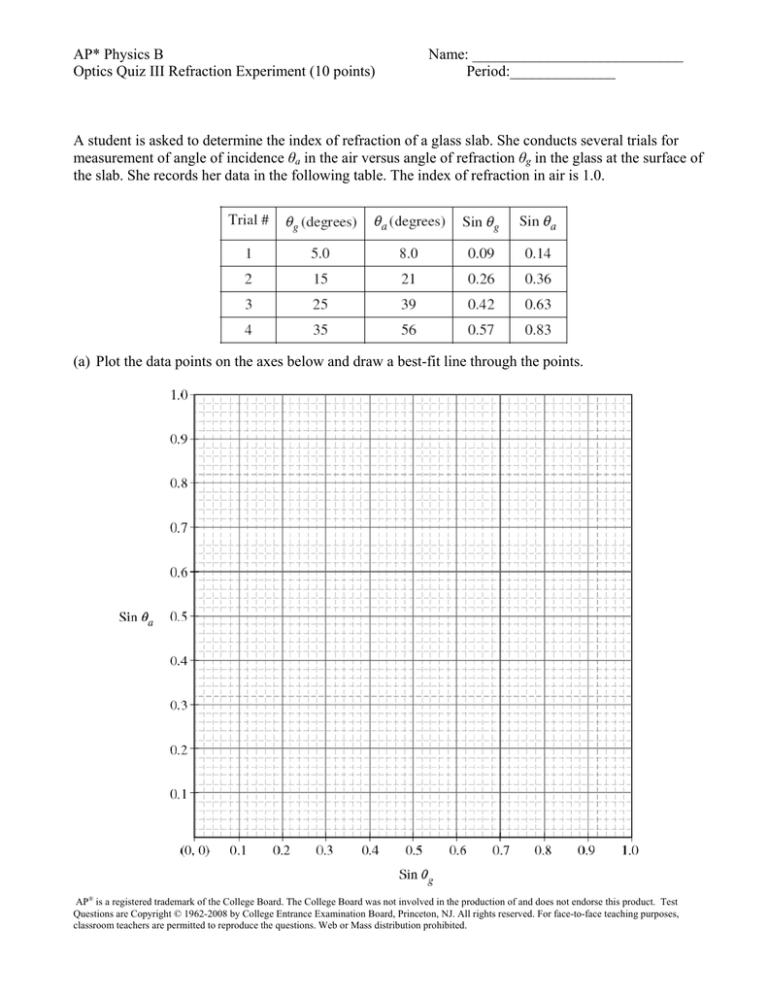
AP* Physics B
Optics Quiz III Refraction Experiment (10 points)
Name: ____________________________
Period:______________
A student is asked to determine the index of refraction of a glass slab. She conducts several trials for
measurement of angle of incidence θa in the air versus angle of refraction θg in the glass at the surface of
the slab. She records her data in the following table. The index of refraction in air is 1.0.
(a) Plot the data points on the axes below and draw a best-fit line through the points.
AP® is a registered trademark of the College Board. The College Board was not involved in the production of and does not endorse this product. Test
Questions are Copyright © 1962-2008 by College Entrance Examination Board, Princeton, NJ. All rights reserved. For face-to-face teaching purposes,
classroom teachers are permitted to reproduce the questions. Web or Mass distribution prohibited.
(b) Calculate the index of refraction of the glass slab from your best-fit line.
(c) Describe how you could use the graph to determine the critical angle for the glass-air interface.
Do not use the answer to the part (b) for this purpose.
(d) On the graph in (a), sketch and label a line for a material of higher index of refraction.
AP® PHYSICS B
2007 SCORING GUIDELINES (Form B)
Question 6
10 points total
(a)
Distribution
of points
3 points
For at least three data points plotted correctly
For a straight line drawn
For the line being a “best fit” to the data points (with equal number of points above and
below the line)
1 point
1 point
1 point
© 2007 The College Board. All rights reserved.
Visit apcentral.collegeboard.com (for AP professionals) and www.collegeboard.com/apstudents (for students and parents).
AP® PHYSICS B
2007 SCORING GUIDELINES (Form B)
Question 6 (continued)
Distribution
of points
(b)
3 points
na sin qa = ng sin qg
na = 1
For recognizing that ng is the slope of the graph of sin qa versus sin qg .
1 point
sin qa = ng sin qg
For using at least two widely separated points on the best-fit line (not two data points)
For example, selecting two points on the line in the graph above, such as (0.08,0.10)
and (0.60,0.88)
Dy
0.88 - 0.10
=
= 1.5
Slope =
Dx
0.60 - 0.08
For the correct slope value, hence the value for ng
1 point
1 point
ng = 1.5
(c)
2 points
The critical angle qc is equal to qg when sin qa = 1
For extending the best-fit line to the point at the top of the graph where sin qa = 1
1 point
For indicating that qc = sin -1 sin qg at this point. (Note: To earn this point it was not
1 point
(
)
required to calculate the actual value for qc .)
© 2007 The College Board. All rights reserved.
Visit apcentral.collegeboard.com (for AP professionals) and www.collegeboard.com/apstudents (for students and parents).
AP® PHYSICS B
2007 SCORING GUIDELINES (Form B)
Question 6 (continued)
Distribution
of points
(d)
2 points
For a line with a slope greater than the best-fit line of part (a)
For the line intercepting the origin (0,0)
1 point
1 point
© 2007 The College Board. All rights reserved.
Visit apcentral.collegeboard.com (for AP professionals) and www.collegeboard.com/apstudents (for students and parents).
©2007 The College Board. All rights reserved.
Visit apcentral.collegeboard.com (for AP professionals) and www.collegeboard.com/apstudents (for students and parents).
©2007 The College Board. All rights reserved.
Visit apcentral.collegeboard.com (for AP professionals) and www.collegeboard.com/apstudents (for students and parents).
AP® PHYSICS B
2007 SCORING COMMENTARY (Form B)
Question 6
Sample: B6A
Score: 9
The only point lost in the response was for the best-fit line in part (a), where two of the points are below the line and
none above it. Although the point for trial 3 is off, the other three points are plotted correctly. The calculation in part
(b) uses two data points, but these points are also on the line, so there was no deduction there. The description in part
(c) is very well written.
Sample: B6B
Score: 7
This response earned full credit for parts (a), (c), and (d) but no credit for part (b) because there is no attempt to use
the best-fit line, as required. Instead, the student calculates the index of refraction from Snell’s law for each of the
data points and then takes the average. While this is a reasonable procedure, the question specifically states that the
best-fit line is to be used.
Sample: B6C
Score: 3
The only points given for this response were the 3 points in part (a) for correctly plotting the data points and drawing
a reasonable best-fit straight line.
© 2007 The College Board. All rights reserved.
Visit apcentral.collegeboard.com (for AP professionals) and www.collegeboard.com/apstudents (for students and parents).


